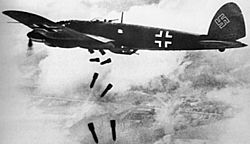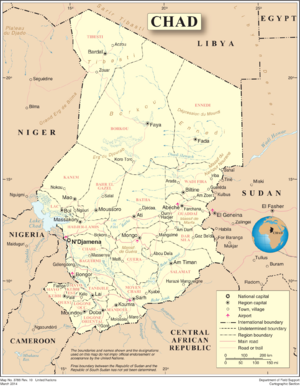Sonderkommando Blaich facts for kids
Quick facts for kids The Western Desert campaign |
|||||||
|---|---|---|---|---|---|---|---|
| Part of North African Campaign | |||||||
 Example of a Heinkel He 111H dropping bombs during the Battle of Britain in 1940 |
|||||||
|
|||||||
| Belligerents | |||||||
| Commanders and leaders | |||||||
| Theo Blaich | Philippe Leclerc | ||||||
| Units involved | |||||||
| Fliegerführer Afrika | |||||||
| Strength | |||||||
| 3 aircraft | |||||||
| Casualties and losses | |||||||
| None | 80,000 imp gal (360,000 L; 96,000 US gal) of fuel destroyed 8 British Hawker Hurricane fighters destroyed |
||||||
The Sonderkommando Blaich (which means Special Command Blaich) was a small German military group. It included a Heinkel He 111H, which was a type of plane that dropped bombs. It also had an Italian Savoia-Marchetti SM.82 transport plane and a Messerschmitt Bf 108 called the Taifun. In January 1942, the Heinkel bomber flew a long way to attack Fort Lamy. This town was controlled by the Free French Forces in the Chad area of French Equatorial Africa. The attack was successful, even though Fort Lamy was about 1,250 miles (2,010 km) from where the German and Italian forces (called the Axis) had their bases. On the way back, the Heinkel plane ran out of fuel and had to land in the desert. Luckily, the crew and the plane were rescued a week later.
Contents
The Secret Raid on Fort Lamy
Why Fort Lamy Was Important
Chad and Fort Lamy were taken over by the Free French in 1940. It became an important stop for their operations, especially for attacks on the Kufra oasis. The Sonderkommando Blaich group usually flew from airfields in Libya, like Hun and Sabha. They were trying to stop attacks by British special forces, such as the Special Air Service (SAS) and the Long Range Desert Group (LRDG). These British groups often attacked Axis fuel and ammunition storage, radio stations, and airfields. Fort Lamy was a key base for the LRDG. It was also part of a route used by the Royal Air Force to fly supplies from RAF Takoradi in Ghana to Egypt.
Who Was Theo Blaich?
Theo Blaich was a German adventurer who owned a plantation. He joined the German army (Wehrmacht) in 1939, even flying his own Messerschmitt Bf 108 Taifun plane. Blaich knew that Fort Lamy was a very important place. It was a key stop on the travel and communication route from Africa's west coast to the Nile River. It was also a meeting point for Allied forces planning attacks against Libya. Blaich suggested that the Axis forces should capture Fort Lamy to protect Libya's southern border. When his idea was turned down, he then suggested at least carrying out a bombing raid. General Erwin Rommel liked this idea and sent it to Generalmajor Stefan Fröhlich, who was in charge of air operations in Africa. The raid was planned for January 21, 1942. This date was chosen to happen at the same time as an Axis attack on the British at El Agheila.
Planning the Attack
The Plan for the Raid
The Sonderkommando Blaich was a team of German and Italian soldiers. They used a Heinkel He 111H bomber. This plane had extra equipment removed, like its top and bottom guns, to make it lighter. They also had a Savoia-Marchetti SM.82 transport plane, which carried extra fuel for the Heinkel. Blaich's own Taifun plane was also part of the group. They were all supposed to leave from an oasis called Hun on January 20. The Heinkel crew and Blaich would go on the bombing raid. The Italian support crew, except for their pilot, Major Roberto Count Vimercati-San Severino, stayed behind.
The Secret Airfield
The Sonderkommando flew to a hidden natural airstrip in southern Libya called Campo Uno (Camp One). Roberto Count Vimercati-San Severino had found this airstrip in 1935 during a safari trip. He had marked it out later, but it had no buildings or facilities. The Marsupiale transport plane was used as a supply base. The Heinkel bomber was refueled by hand from fuel drums. The people who flew on the mission were:
- Hauptmann Theo Blaich, who piloted the Bf 108B Taifun and led the raid.
- Leutnant Franz Bohnsack, the pilot of the He 111.
- Feldwebel Heinrich Geissler, the navigator (who guided the plane).
- Unteroffizier Wolfgang Wichmann, the wireless operator (who handled radio communication).
- Leutnant Fritz Dettmann, a war reporter.
- Maggiore Roberto Count Vimercati-San Severino, a desert expert and pilot of the Marsupiale.
The Flight to Fort Lamy
The Heinkel He 111 took off from Campo Uno at 8:00 AM on January 21. But they ran into bad weather, even though the forecast said it would be clear. The plane had 1,000 imperial gallons (4,500 L) of fuel, but the bad weather made them use more fuel than expected. Geissler, the navigator, had to guide the plane using dead reckoning. This meant estimating their position because there were no radio stations to help them. After many hours, Geissler realized they were over 100 miles (160 km) off course. He told the pilot to turn west towards the Chari River. They then flew along the river to Fort Lamy, which is where the Chari and Logone rivers meet near Lake Chad. The Heinkel reached the lake by noon, and navigation became easier, even though the storm got worse. At 2:30 PM, flying at 1,500 feet (460 m), the Heinkel arrived at Fort Lamy.
Bombing the Fuel Depot
Because Fort Lamy was so far away from the main fighting, its airfield and supply depot had no air defenses. The Heinkel crew couldn't wait and made one quick bombing run. They dropped sixteen 100 kg (220 lb) bombs without any trouble onto the fuel storage area near the airfield. The French forces were too surprised to fight back. The raid destroyed 80,000 imperial gallons (360,000 L) of fuel, all of their oil, and eight Hawker Hurricane fighter planes that were nearby.
The Tricky Return Journey
The Heinkel plane was not damaged. It turned north, but the crew knew that because of the detour, they did not have enough fuel to reach Campo Uno. They ran the engines using as little fuel as possible, at 1,950 rpm, to fly as far as they could. They had lost radio contact with the Italian support crew on the way to Fort Lamy and could not get it back. At 6:00 PM, as the sun was setting, the Heinkel was still 160 miles (260 km) short of Campo Uno. Bohnsack, the pilot, had to make an emergency landing on a high plateau. The six men only had 20 liters (4.4 imp gal) of water. Wichmann, the radio operator, set up his small 3-Watt radio antenna using tent poles.
Getting Rescued
On 6,197 kHz, Wichmann managed to contact a radio operator at the headquarters of the German air force in Benghazi, about 650 miles (1,050 km) to the north. The Italian support crew was still out of contact. Three days later, Benghazi sent a message that the Italians had been reached and were looking for the Heinkel. On the fifth day, the crew sent a special radio signal using the Heinkel's wireless. They ran one engine with the last bit of fuel to power the radio. Within an hour, an Italian Caproni Ca.309 plane landed and brought water and melons to the Heinkel crew. The next day, a Junkers Ju 52 transport plane arrived with more water and fuel. The crew then took off for the short trip to Campo Uno. There, the Heinkel was refueled, and the crew flew on to Hun.
What Happened After the Raid?
The attack on Fort Lamy caused only minor damage to buildings and few injuries. However, it destroyed a lot of fuel supplies, even though people tried hard to save them. This cut the fuel available to the Free French and the RAF in the area by half. Because of the raid, General Philippe Leclerc decided to make Fort Lamy's anti-aircraft defenses stronger. He also started quick attacks against the Italian forces in the Fezzan region of Libya. The Sonderkommando Blaich continued to operate against the LRDG during the first half of 1942. In June 1942, the Heinkel bomber crashed near Kufra after one of its engines failed. The crew was rescued four days later, but they had to set the Heinkel on fire so it wouldn't fall into enemy hands. This event ended the Sonderkommando's operations.




